Keywords
|
| Thick substrate, L-probe feed, Aperture Feed, Coaxial Feed, Proximity Feed, Edge Feed |
INTRODUCTION
|
| During the previous few decades, many efforts have been dedicated to bandwidth widening techniques of micro strip antennas, including the use of impedance matching [2], multiple resonators [3], and a thick substrate [4], Low bandwidth (but can be improved by a variety of techniques). Bandwidths improvements of a few percent are typical. Efficiency may be lower than with other antennas. Efficiency is limited by conductor and dielectric losses, and by surface-wave loss. Conductor and dielectric losses become more severe for thinner substrates. Surface-wave losses become more severe for thicker substrates (unless air or foam is used). The bandwidth is usually specified as the frequency range over which the VSWR is less than 2 (which corresponds to a return loss of 9.5 dB or 11 % reflected power). Sometimes for stringent applications, the VSWR requirement is specified to be less than 1.5 (which corresponds to a return loss of 14 dB or 4 % reflected power). The band width is measured by: |
 (1) (1) |
RELATED WORK
|
| Proximity feeding suffers from inherently low coupling levels and difficulties in impedance matching. An impedance bandwidth of about 30% was typically achieved if a proper U-slot was cut in the patch [6]. The BW of CMSA (Circular Micro Strip Patch) is increased by cutting the slot at an appropriate position inside the patch and these slot cut CMSAs are optimized on substrates with thickness more than 0.09λo, the proximity feeding as well as L-probe feeding has been used [4, 9, 16]. For this basis, various efficient methods [5-8] were proposed to solve this problem, including the use of probe compensation [5], the U-slot [6], the L-probe feed [7], and use of the T-probe feed [8]. The approach using an Lshaped probe feed a rectangular patch was also found to yield an impedance bandwidth of 35% [7]. A T-probe-fed rectangular patch antenna attains an impedance bandwidth of 40% [8]. All of the U-slot, L-probe, and T-probe patch antennas are of the single-layer single-patch type; with smaller volume but larger bandwidth than the design utilize parasitic patches with a coax feed, which rarely exceeds 20%. Recently, those bandwidth enhancement systems pointed out above were engaged to the short-circuited patch antennas to comprehend a wide impedance bandwidth [12-14]. An impedance bandwidth of 30% was achieved using two stacked shorted patches [12]. However, the stacked geometry may augment the complexity of the antenna. This problem can be solved up to a fine extent by using a slot in the ground plane. The slot in the ground plane helps to couple more power to the patch [13]. The size of the slot can be used for impedance matching. And with this wider bandwidths can be achieved. It has been shown in [11] that impedance bandwidth as high as 21% can be accomplished. |
ENERGY FEED METHODOLOGIES
|
| The mechanism of coupling energy, equivalent circuit diagram and relative merits are discussed in this paper. Feeding techniques are govern by many issues like efficient transfer of power between the radiation structure, feeding structure and their impedance matching along with impedance matching are stepped impedance bends, stub function, transition which removes spurious radiation & surface wave loss. This radiation may increase the side lobe & cross polarization amplitude of radiation pattern. Most important factor is to remove the spurious radiation and it effect on radiation pattern is use to evaluate feed. Some feed structures are tends to better performance because of the large no of parameters available. |
| A. Disadvantages of Micro strip Antennas (BW/Impedance matching): |
| Feeding techniques are ruled by many factors like efficient transport of power between the radiation structure, feeding structure and their impedance matching techniques. The major limitation of patch antennas is their narrow band width of around 5%, especially if probe fed or micro strip line feed patch design are used. The bandwidth restraint can be surmounted by differing from classic design. Introducing parasitic elements to the patch or cutting slots to diverge the surface current distribution, including the use of high-dielectric-constant substrate and cover layers [9], a short circuit [10], and a short pin [11], can get better the bandwidth further. Proximity and Aperture coupled feeds are non contacting schemes, in which electromagnetic field coupling is done to transport power among the micro strip line and the radiating patch. In proximity feeding, a coupling strip is placed below the radiating patch and through the electromagnetic coupling linking patch and strip, a broadband response is realized. For an electrically thick substrate patch antenna, the coaxial supply is typically used. However, the probe inductance limits its impedance bandwidth to less than 10%. |
| B. Feeding Techniques |
| Micro strip patch antenna can be fed by a variety of methods (Ojha et al, 2011) These methods can be classified into two categories-contacting and non contacting .In the contacting methods , the RF power is fed directly to the radiating patch using a connecting element such as a micro strip line. In non contacting scheme, electromagnetic field coupling is done to transfer power between the micro strip line and the radiating patch. The four most popular feed techniques used are the micro strip line, coaxial probe (both contacting scheme). |
| B.1 Coaxial Probe Feed |
| Advantages: Simple, easy to obtain input match, feed can be placed at any desired location inside the patch Disadvantages: Difficult to obtain input match for thicker substrates, due to probe inductance, significant probe radiation for thicker substrates. |
| The coaxial feed or probe feed is a very general technique uses inner conductor of the coaxial connector extended through the dielectric and is soldered to the radiating patch, with outer conductor connected to the ground. For thicker substrate the enlarged probe length makes the input impedance more inductive leading to matching inconvenience. Excitation of patch occurs principally through the coupling of the feed current Jz to the Ez field of the patch mode. Coupling constant can be obtained as: |
 (2) (2) |
| Where L is the resonant length of the patch and xo is the offset of the feed point from the patch edge equation (13) shows that coupling is maximum for a feed located at a radiating edge of the patch (xo = 0 or L) . Resulting impedance can be made by an equivalent circuit as shown in figure 1. It is represented by parallel circuit of capacitor Co and inductor Lo of probe and inductance of patch Lp. |
| B.2 Micro strip Line Edge Feed |
| Advantages: Simple, allows for planar feeding, easy to obtain input match. Disadvantages: Significant line radiation for thicker substrates, for deep notches, pattern may show distortion. It is represented by T shape circuit of capacitor Co and inductor Lo of strip and inductance of patch Lp. However increase in thickness of the dielectric substrate being used also makes surface waves and spurious feed radiation also increases, which hampers the bandwidth 2-5% of the antenna. This feed radiation also leads to undesired cross polarized radiation. Coupling formula is similar as coaxial probe feed. The edge-coupled micro strip feed can be modelled by means of the step in width or impedance junction. The equivalent circuit is in figure1. |
| B.3 Aperture Coupled Feed |
| Advantages: Feed radiation is isolated from patch radiation and superior bandwidth, since probe inductance problem restriction is eradicated and a double-resonance can be produced, Uses of different substrates to optimize antenna and feed-circuit performance, Allows for planar feeding, |
| Disadvantages: Necessitates multilayer fabrication and alignment is important for input match. |
| In this type of feed technique the radiating patch and the micro strip feed line are detached by the ground plane so spurious radiation is minimized as shown in figure 3. Coupling between the patch and feed line is made through a slot or an aperture in the ground plane where variations upon the size i.e. length and width of the aperture varies coupling. To optimize the results for wider bandwidth and better return loss the coupling aperture is usually centred under the patch leading to lower cross-polarization due to evenness of the configuration. Furthermore, aperture coupled feeding allows independent optimization of antennas and feed networks by using substrates of different thickness or permittivity. The coupling slot is nearly centred with respect to the patch where the magnetic field of the patch is maximum. This is done purposely to enhance magnetic coupling between the magnetic field of the patch and equivalent magnetic current near the slot. |
| B.4 Proximity Couple Feed (Electromagnetic Coupling Scheme) |
| Advantages: Allows for planar feeding, less line radiation compared to micro strip feed. |
| Disadvantages: Requires multilayer fabrication, alignment is important for input match. |
| The two dielectric substrates are used such that the feed line is in the interior of two substrates and radiating patch is on the top of higher substrate and feed line end beneath the patch. It is also known as electromagnetic coupled micro strip line .Coupling between the patch and micro strip behave capacitive in nature .The equivalent circuit diagram of this feed is shown in figure 2. Coupling capacitor Cc is in series with the parallel R-L-C resonant circuit representing the patch. Requirement of this coupling is to match the impedance and tuning of the bandwidth. The open end of the micro strip feed gives stub and stub parameters which help in recuperating bandwidth. By using this feeding technique 13 % of extra Bandwidth is reached. It is effective to use two layers as it increase the bandwidth and reduce spurious radiation, but it is difficult to form right alignment of the patches. Advantages are that less line surface and leaky wave radiation than other feed. |
| Thus one can make out that selection of the feeding technique for a micro strip patch antenna is an vital decision because it affects the bandwidth, reflection coefficient, VSWR, patch size and smith chart. The well concluded parameters are: A micro strip patch antenna excited by different excitation techniques gives different band width, different gain and different efficiency etc. Coaxial feeding technique gives the least bandwidth .We can also conclude that by changing the feed point where matching is perfect. The high return loss can be achieved at the resonant frequency. |
| The maximum bandwidth can be achieved by aperture coupling. Proximity coupling gives the best impedance matching and radiation efficiency. A new micro strip patch antennas with combination of different feed technique is present with various parameters like return loss, smith chart, VSWR. The performance properties are analyzed for the optimized dimensions and proposed antenna works well at the required (2.25-4.15) GHz frequency band. |
| C. Proximity and Inset Feed Structures in literature |
| In proximity feeding, a coupling strip is placed below the radiating patch and by means of the electromagnetic coupling between patch and strip, a broadband response is realized. A key attribute of the proximity-coupled patch is that its coupling mechanism is capacitive in nature. This is in contrast to the direct contact methods, which are predominantly inductive. The difference in coupling significantly affects the obtainable impedance band width, because the inductive coupling of the edge and probe-fed geometries limits the thickness of the material useable. Thus, bandwidth of a proximity coupled patch is inherently greater than the direct contact feed patches. The shorting next to the feed forms a transmission line with it and adds a capacitive component to the input impedance that counteracts the patch and feed inductance. As the shorting is moved farther away from the feed, the capacitance decreases and the shorting becomes an inductive component, as it is in the quarter-wave patch. In L-probe feeding the broader bandwidth (BW) is realized owing to electromagnetic coupling linking horizontal section of the L-probe strip and the patch mode. Also in L-probe feeding the comprehended BW also depends upon the ratio of vertical strip length to its horizontal length for the given patch substrate thickness |
| An inset cut can be introduced at the connection point to improve the impedance matching. The inset-fed micro strip antenna provides a method of impedance control with a planar feed configuration [1-2]. The experimental and numerical results showed that the input impedance of an inset-fed patch varied as a Cos4 function of the normalized inset depth D. It is found that a shifted Cos2 function works well for the inset-fed patch [4-5]. The parameters of the shifted cosine-squared function depend on the notch width for a given patch and substrate geometry. An analysis shows that the inset disturbs the transmission line or cavity model and augments the impedance variation with distance compared to a coaxial probe feed given a patch resonant length L and feed position x from the centre |
 (3) (3) |
| is an approximate solution because at x = 0, the resistance remains finite [7]. Locating the feed from the equation using a radian angle measure: |
 (4) (4) |
| The inset feed introduces a physical notch, which in turn introduces a junction capacitance. The physical notch and its corresponding junction capacitance influence the resonance frequency. As the inset feed-point moves from the edge toward the centre of the patch the resonant input impedance reduces monotonically and reaches zero at the centre. When the value of the inset feed point approaches the centre of the patch, cos2 (πA/L) equation for impedance varies very rapidly; therefore the input resistance also changes quickly with the position of the feed point. For thicker substrates, the edge feed method suffers from spurious radiation caused by feed line. This not only influence the bandwidth, but also guides to undesirable cross polarized radiation. Feed matching for side feed technique is challenging. |
PROPOSED IDEA AND DESIGN
|
| A. Prototype antenna for Discussion: |
| In this paper a micro strip extension of antenna on thicker substrate is realized by using L-probe non-contact feeding technique with circular patch (CMSA) [14]. The non-contact feeding techniques of micro strip antenna, namely proximity feed with L-probe feed the simplest method to implement in thicker substrates is presented which have performance in provisions of bandwidth and radiation pattern. These techniques to augment bandwidth include bringing in multiple resonances into the structure [3]. This may obtain the form of stacked patches, coplanar parasitic patches, or patches so as to have novel shapes such as the rectangular shaped slot patch antenna. Using special feed networks or feeding techniques [4] to give back for the natural impedance variation of the patch is another method. Etching a slot on the patch is a simple design. This design avoids the use of stacked or coplanar parasitic patches, either of which enhances the thickness or the lateral size of the antenna. So, while changing the current distribution on the micro strip patch, by enhancing the impedance bandwidth sometimes more than one resonant frequency is obtained [5].The circular micro strip patch antenna made-up on the substrate (εr = 1.1), (h = 1.1 cm) and at the resonant frequency (fr = 3.58 GHz) provide almost same directivity (8 dB) and efficiency (96%) [14]. The circular patch and its equivalent rectangular patch is shown in Fig.1. For the equivalent rectangular patch of width W = 2A, the length L = (πA/2) is obtained by with the invariance of electrostatic energy under both the rectangular and circular patches [10]. |
| B. Antenna Design And Geometry |
| In this paper, a two slot micro strip antenna has been designed implementing the above facts to achieve a wide bandwidth. Figure 1 shows the geometry of inset feed micro strip antenna with two slots in the patch. The antenna is fabricated on foam substrate of relative dielectric constant (ÃâÃâr) of 1.1 and thickness 11 mm. The L-strip, horizontal part of length Li under patch is kept less than quarter wavelength (Li < λ0 / 4) which provides a capacitance to suppress the inductance introduced from the vertical part of L-strip. Vertical part of L-strip = h2 is the series arrangement of resistance RS and inductance LS. The series resistance RS arises due to finite conductivity of copper used. The whole structure of L-strip acts as a series LC resonance elements which are connected in series with a parallel RLC resonant element of the patch. The formulas for the calculation of above constraints are given in [18]. |
| The patch antennas consist of a metallic patch that is on top of a stranded dielectric substrate of thickness H. For substrate thickness greater than 0.04 to 0.05λ0, the antenna BW is restricted by the feed probe inductance, since the input impedance locus for the same cannot be optimized inside the VSWR = 2 circle [5, 12]. By means of substrate thickness more than 0.05λ0, the antenna BW is increased by using different feeding techniques like, L-probe feed and proximity feed where BW of CMSA is as well increased by cutting the slot at an appropriate location inside the patch and these slot cut MSAs are optimized on substrate of thickness 0.06 to 0.08 λ0 [4 – 6]. The edges of the patch act approximately as a cavity with perfect electric conductor on the top and the bottom surfaces, and a perfect “magnetic conductor” on the sides. When the antenna is get excited at a certain resonance frequency, a strong electric field produced on the surface of the patch that is basically z directed and independent of the z coordinate. Each mode radiates, but it necessitates more and more stored energy as the mode number enlarges. The patch cavity modes are described by a double index (say n, p). The cut off frequencies of TE modes of circular waveguides give the resonant frequencies of |
 (5) (5) |
| where X’np are the zeros of the derivative of the Bessel function Jn(x) of order n, as is true of TE-mode circular waveguides. The term Aeff is an effective radius of the patch |
 (6) (6) |
| where A is the physical radius and H is the substrate thickness. Using the effective radius gives the resonant frequency within 2.5%. We combine equations as written in above to determine radius to give a particular resonant frequency: |
 (7) (7) |
| The TM01 mode (X’01= 3.83171) produces a monopole-type pattern from a homogeneous edge fringing field. The radial line alongside which the feed is placed determines the direction of the linear polarization. The non uniform radiation along its edge offers larger edge impedance than the square patch. Experience shows that the 50Ω feed point is located from the centre at about one-third the radius. |
| Here base CMSA is said to be the circular structure (radius=17mm) without any slot and slot 1 is a slot shown over strip line feed and an optional slot is shown at Pn distance in axial length from the first slot with (17x4). It is kept as optional slot as it is used in literature for similar dimensions. Wherever inset term is used it is due to famous structure of micro strip line feed by inset method. The inset feed here is named only due to geometrical symmetry from the view point if seen from the top (towards z direction). Fig. 5 shows the geometry of inset feed micro strip antenna with two slots in the patch. The patch is energized electromagnetically using 50 ohm micro strip feed line. |
RESULTS AND DISCUSSION
|
| The patch is proximity fed by a L-shaped micro strip line, and it is excited in the TM11-mode and have the centre operation frequency, 3.58 GHz. The reflection coefficient of an antenna shows how well antenna port is matched by source. A good reflection coefficient or VSWR alone is not all measure of a good antenna as it does not tell how fine the radiation is taking place in the required directions and conditions. |
| The results for the reflection coefficient variation and SWR due to different amendment on patch of the antenna are shown in Figure 3 and Fig.4. The value of S11 is resulted (3.22-3.68 GHz which is 13% impedance BW) for CMSA, which was achieved at 2.80-3.90 GHz (32.8%) by slot over feed line and 2.90-3.75 GHz (28.7%) due to optional slot 2 and it is observed that when both the slots were measured the impedance bandwidth becomes (S11 < -10dB for 2.25- 4.15 GHz), which is an improvement of 59% in CMSA impedance BW. |
| The measured SWR is < 2 in the frequency range 2.22-4.18 GHz, corresponding to an impedance bandwidth of 60.2% has been achieved by both slot structure. Which was found matched to source as (1<SWR<1.5 for 2.75-3.85 GHz, almost 34%). |
| The Smith Chart is designed on the complex reflection coefficient plane in two dimensions and is extended in normalized impedance used for problems involving any characteristic impedance or system impedance, while by far the most commonly used is 50 ohms. The proposed antenna design gives better impedance matching bandwidth which is shown by inset antenna coefficient plotted within 50 Ω for the scope of frequencies in study. By this it can be inferred that the antenna is perfectly matched and the power loss is least. |
| The L-feed horizontal length incorporated below the patch introduces a capacitance repressing some of the inductance commenced by the vertical feed length due to thick substrate, and another resonance near the resonance of the patch antenna can be created. The measured and computed results for the input impedance are shown in Figure 6. Here the conjugate match factor shows on a linear scale as for different structure what % of reactive component are reasonable (1=100%). |
| Exploration of radiation efficiency is performed. Radiation efficiency of an antenna is defined as ratio of power radiated to power given to antenna without return loss at antenna port. However, the antenna efficiency is said as ratio of radiated power to actual power fed to antenna (includes return loss at port). The above simulation based measurements are better in terms of radiation pattern, to result obtained in literature for the circular similar micro strip antenna [14]. |
| As in the simulation results pragmatic that by increasing the di-electric constant the BW has been further improved, but it leads to thin substrate material which disturbs dimensions of L feed vertical length and so the inductance and series resistance formed by it. It can be seen that when the thin dielectric is used for higher dielectric constant it reduces the patch radiation efficiency as it improves radiation from antenna which is further added in broadside total radiation as can be seen by other properties. Total antenna efficiency and radiation efficiency is shown in fig. 7. The antenna efficiency remains above 80% for the entire range. The radiation efficiency remains equal to CMSA base and CMSA with both slots i.e. equal to 85-98% for entire range. |
CONCLUSION
|
| In this work we studied the characteristics and equivalent circuit of different feed structure that can be used to connect a patch antenna to its source. As a result, the input impedance plot in Fig 3.2 shows that around the desired radiating frequency, sufficient reactance cancellation can only occur inside a narrow bandwidth. In addition, one needs to match the resonant resistance with the characteristic impedance of the feed line. A small antenna can be tuned to resonate with an appropriate addition of reactance, or it can be made to self-resonate so that the reactance cancellation at resonance happens naturally in the antenna structure. Since adding external reactance for this purpose increases the power loss and it also requires extra space, it is advisable to follow the second alternative. The fringing field modes may have been channelized for good electromagnetic coupling, which is established by varying dielectric constant of lower layers. Using a foam layer of thickness 11mm supported substrate, over original CMSA an enhancement of 35% (Total=59%) in impedance bandwidth was achieved for electro magnetically-coupled triple-layered double notched patch. Thus for many applications, this geometry eliminates the need for the parasitic elements and thin dielectric constant substrate necessary to support them. |
Tables at a glance
|
 |
 |
| Table 1 |
Table 2 |
|
| |
Figures at a glance
|
 |
 |
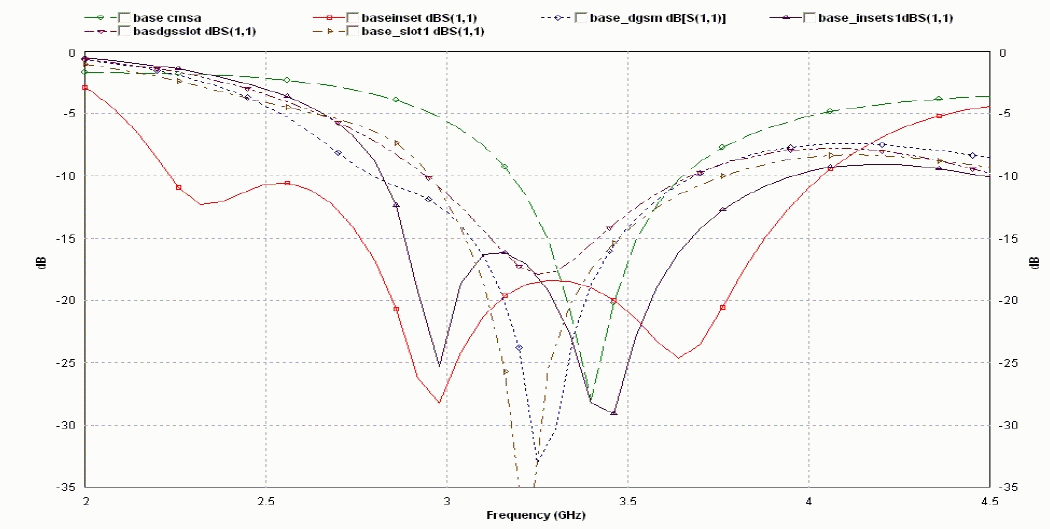 |
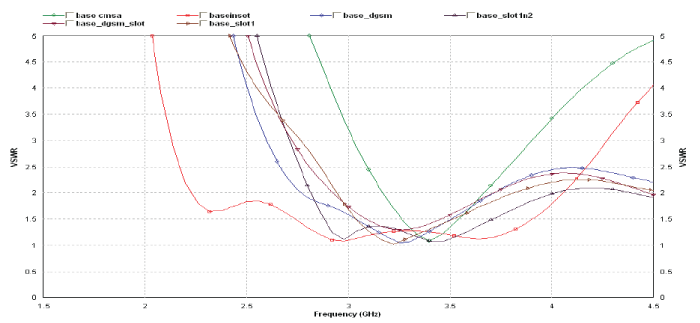 |
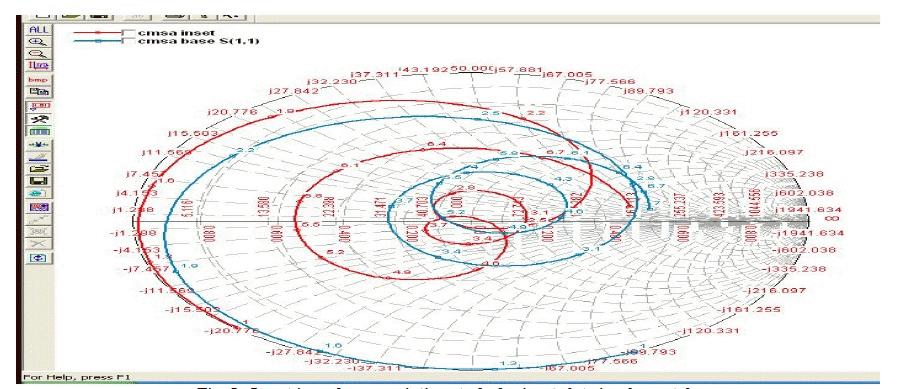 |
| Figure 1 |
Figure 2 |
Figure 3 |
Figure 4 |
Figure 5 |
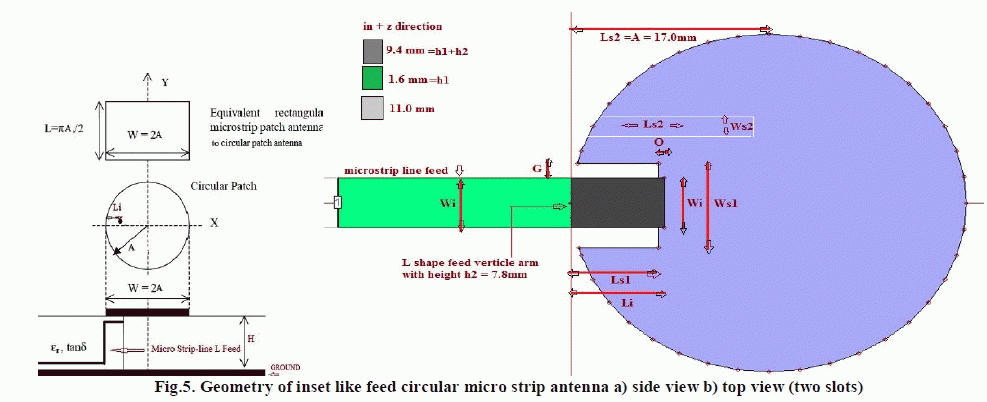 |
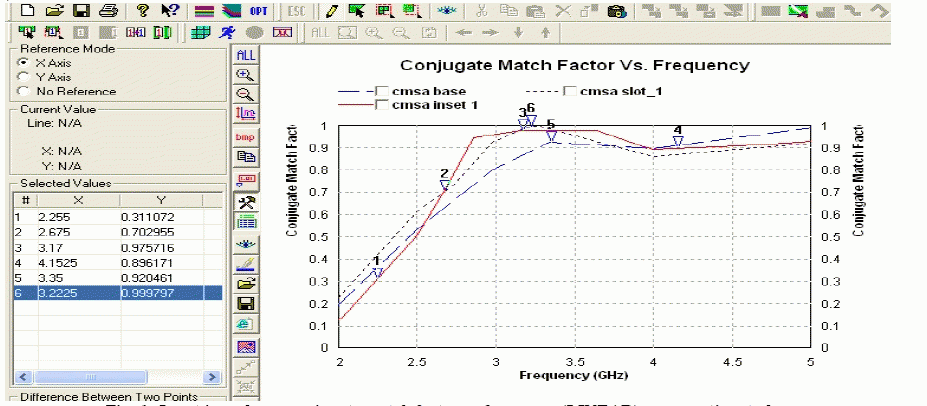 |
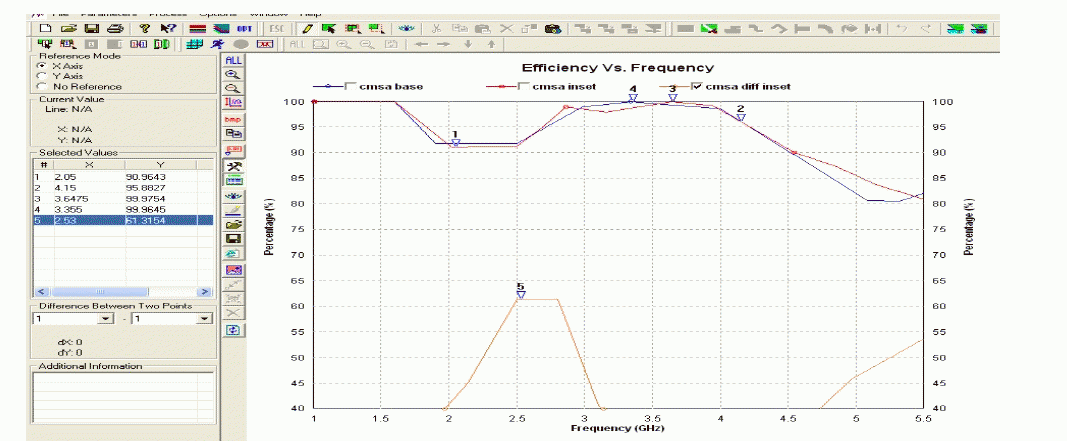 |
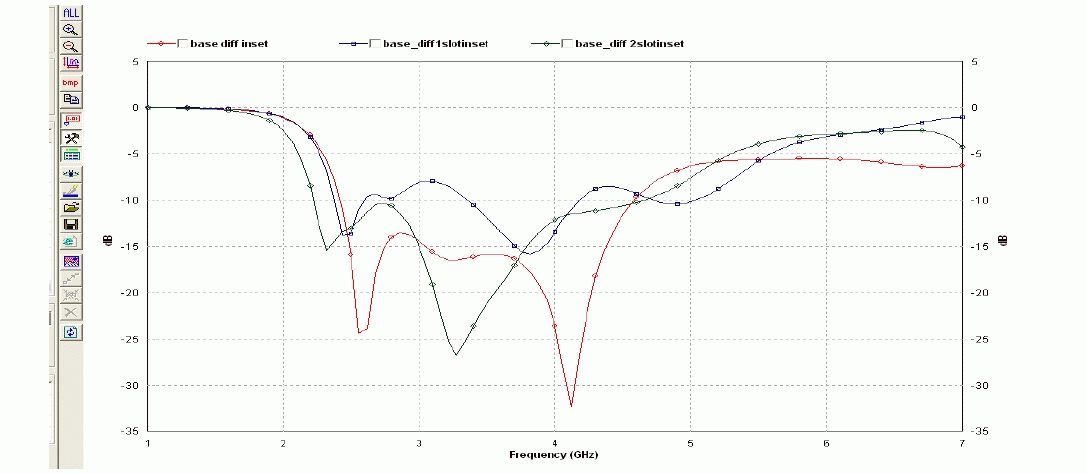 |
| Figure 6 |
Figure 7 |
Figure 8 |
Figure 9 |
|
| |
References
|
- Amit A. Deshmukh and Girish Kumar, “Broadband Pairs of Slot Loaded Rectangular Microstrip Antennas”, Microwave and Optical Technology Letters, Vol. 47, No. 3, pp. 223-226, 2005.
- H.F. Pues and A.R. Van De Capelle, “An impedance matching technique for increasing the bandwidth of micro strip antennas”, IEEE TransAntennas Propagate 37 Ãâ¦Ã½1989., 1345_1354.
- Y. X. Guo,1,2 K. M. Luk,2 and K. F. Lee3, “Regular Circular And Compact Semicircular Patch Antennas With A T-Probe Feeding” , Microwave And Optical Technology Letters / Vol. 31, No. 1, October 5 2001
- L. Mak, K. M. Luk, K. F. Lee, and Y. l. Chow, “Experimental study of a microstrip patch antenna with an L-shaped probe,” IEEE Transactionson Antennas Propagation, Vol. 48, No. 5, pp. 777-783, 2000.
- K.M. Luk, Y.X. Guo, and K.F. Lee, “L-probe Proximity Fed U-Slot Patch Antenna,” Electron Lett34, pp. 1806- 1807, 1998.
- T. Huynh and K.F. Lee, Single-layer single-patch wideband micro strip antenna, Electron Lett 31 Ãâ¦Ã½1995., 1310_1312.
- T. Archevapanich, J. Nakasuwan, B. Purahong, N. Anantrasirichai, O. Sangaroon, “Inset Dual U-Strip Slot Antenna Fed by Microstrip Line forWLAN Applications” International Conference on Control, Automation and Systems in COEX, Seoul, Korea, pp. 14-17, 2008.
- A. Deshmukh and G. Kumar, “Various slot loaded Broadband and Compact Circular Microstrip Antennas”, Microwave and Optical Technology Letters, vol. 48, no. 3, Mar. 2006, pp. 435 – 439.
- M.K. Meshram, “Analysis of L-strip Proximity Fed Rectangular Microstrip Antenna for Mobile Base Station,” Microwave and Optical Technology Letters, vol. 49, no. 8, pp. 1817-1824, Aug. 2007.
- Zhongbao Wang, Shaojun Fang, and Shiqiang Fu, “Wideband Dual-Layer Patch Antenna Fed by a Modified LStrip”, Journal of Microwaves,Optoelectronics and Electromagnetic Applications, Vol. 9, No. 2,pp. 89-100, 2010.
- ROBERT, B., RAZBAN, T., and PAPIERNIK, A.: “Capacitors Provide impedance matching of micro strip antennas”. Microw.RF. PP. 65,1994, 33, (i)p,p . 103-166
- W. C. Chew and J. A. Kong, “Analysis of a circular Microstrip Disk Antenna with a thick Dielectric Substrate,” IEEE Trans. on Antennas andPropagation, Vol. AP-29, pp. 68-76, Jan.1981.
- T. C. Edward, Foundation for Microstrip Circuit Design, john Wiley, 1983.
- Ganga Prasad Pandey, Binod Kumar Kanaujia, A. K. Gautam and Surendra K. Gupta, “Ultra-Wideband L-strip Proximity Coupled Slot LoadedCircular Microstrip antenna for Modern Communication Systems”, Wireless Personal Communication, published on line june 09, 2012, DOI10.1007/s11277-012-0684-5.
- Stuart A. Long, Liang C. Shen, Mark D. Walton and Martin R. Allerding, “Impedance of a Circular Disc Printed Antenna”, Electronics letters,Vol. 14, No. 21, 1978
- Y.X. Guo, C.L. Mak, K.M. Luk, and K.F. Lee, “Analysis and design of L-probe proximity-fed patch antennas”, IEEE Trans Antennas Propagat 49 Ãâ¦Ã½2001., 145_149.
- Pozar, D.M.; Kaufman, B., "Increasing the bandwidth of a micro strip antenna by proximity coupling," Electronics Letters vol.23, no.8, pp.368,369, April 9 1987
- Zeland Software Co., IE3D v14.0, California, USA
- BALANIS, CA.: ‘Antenna Theory’ (Wiley, 1997),
|